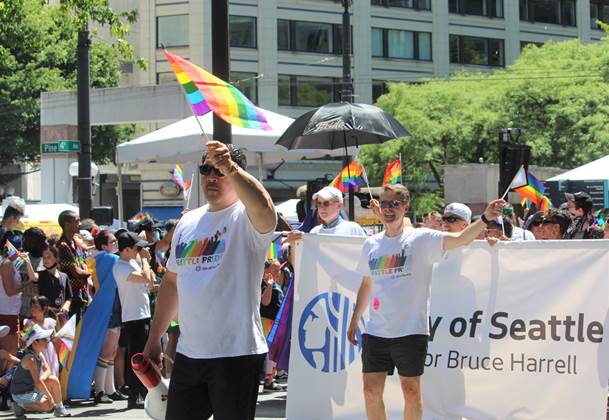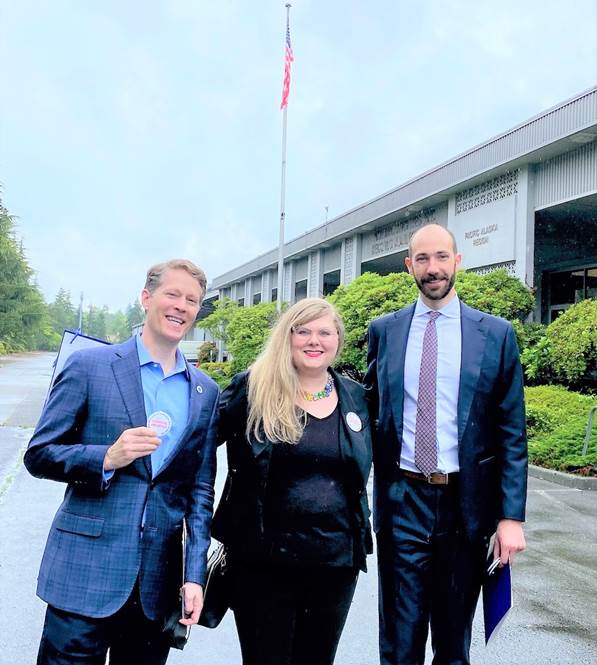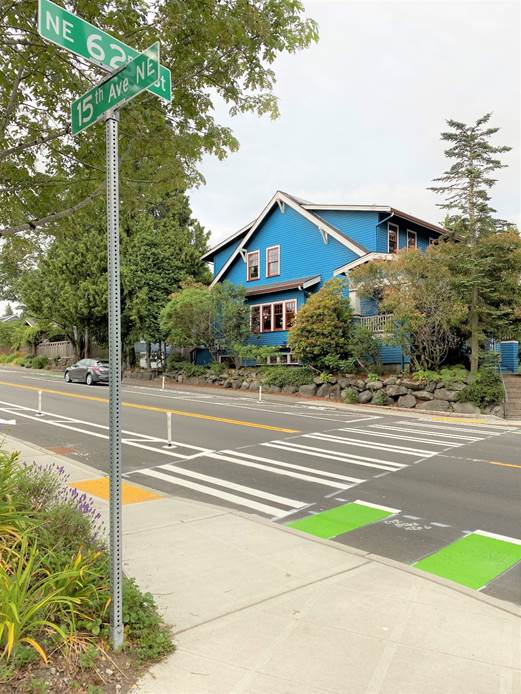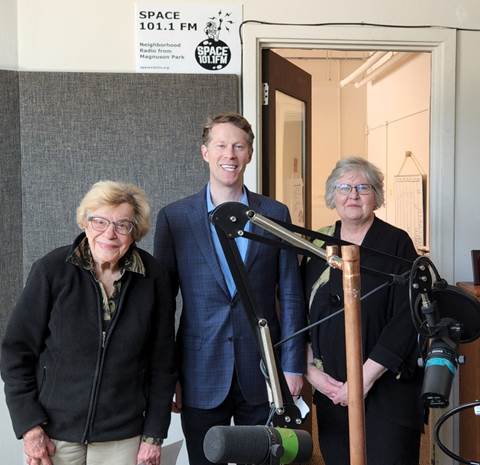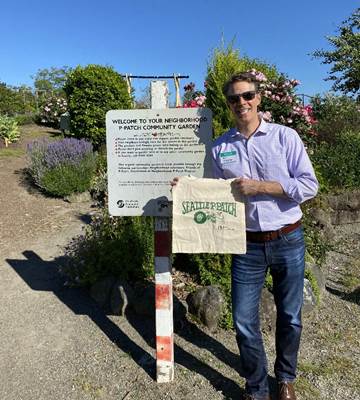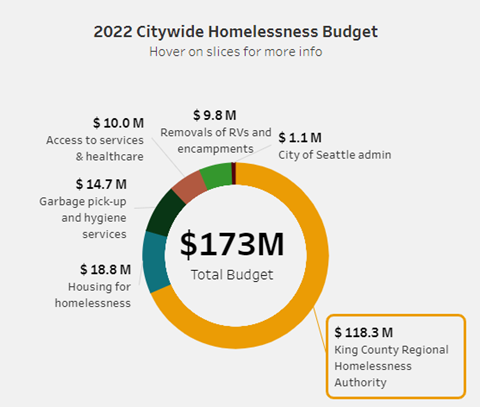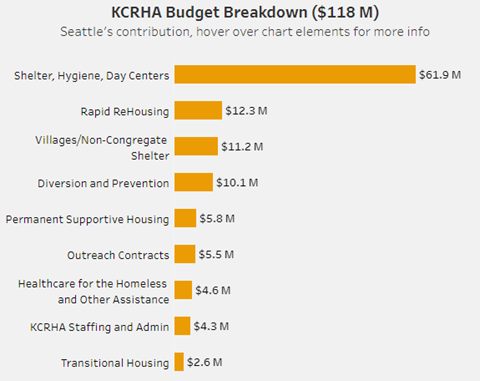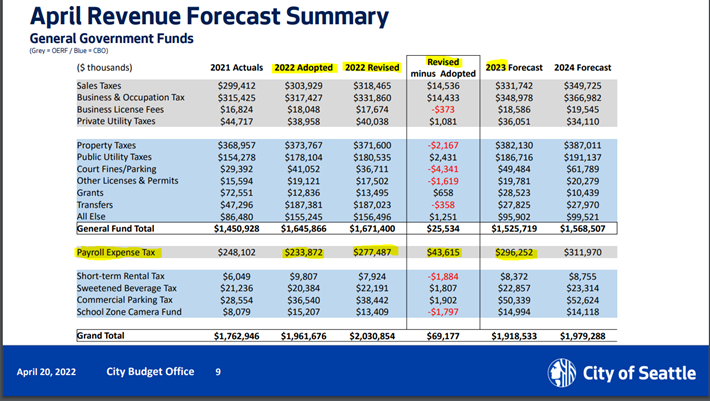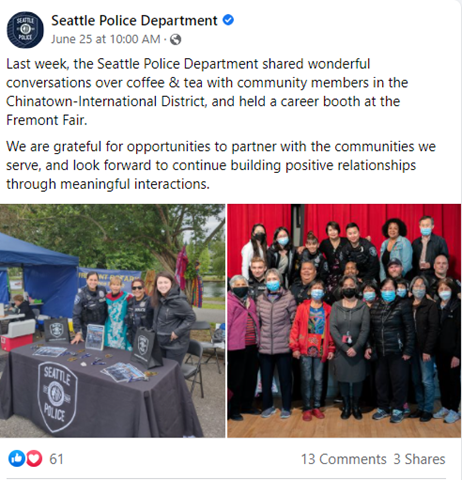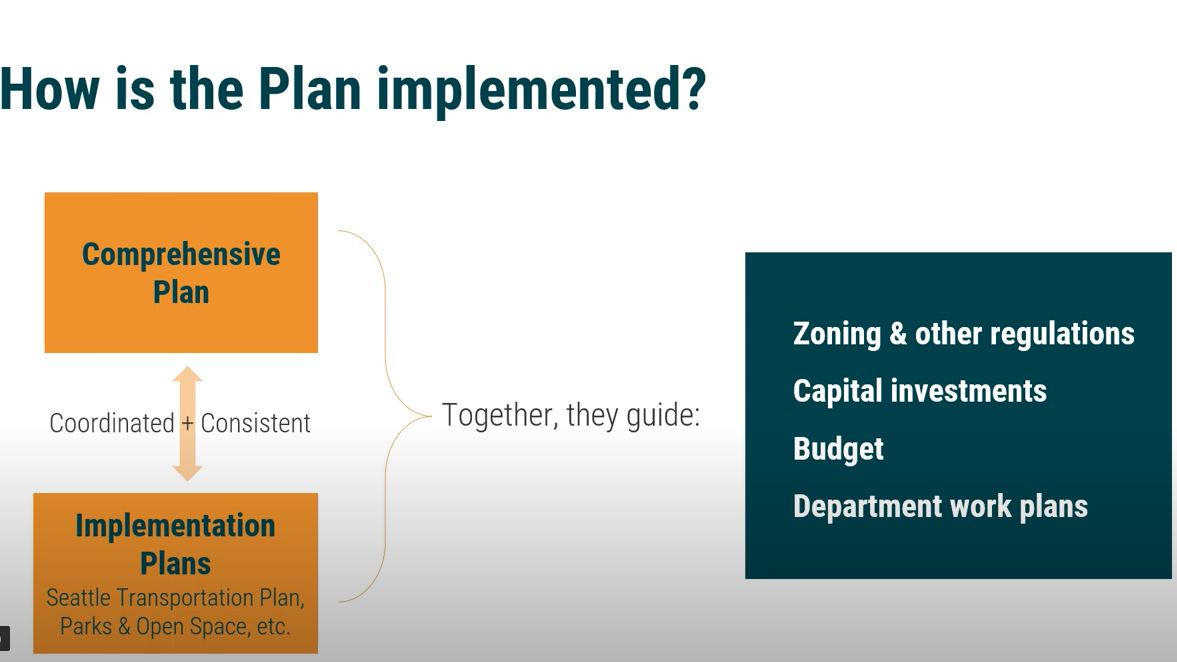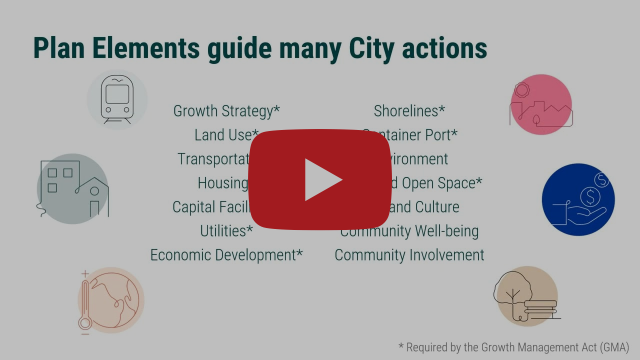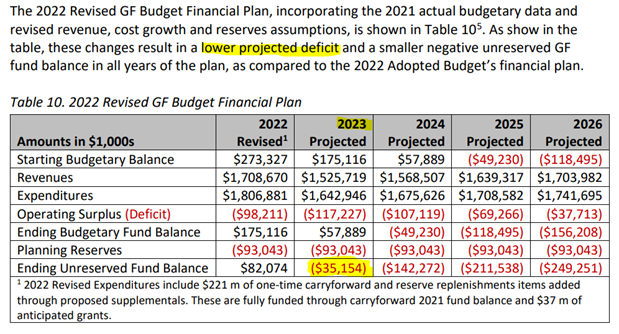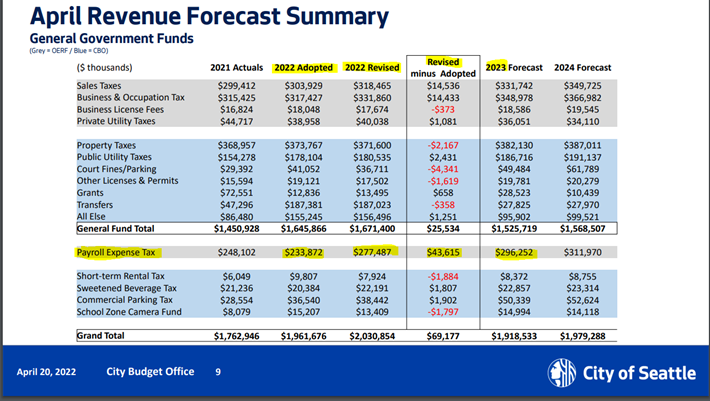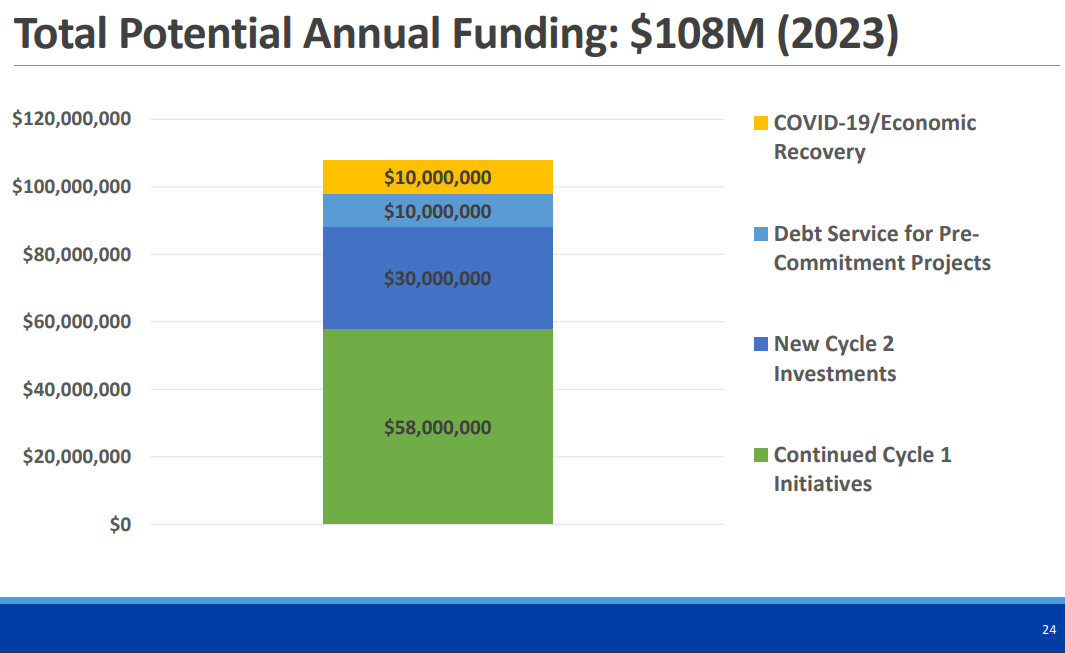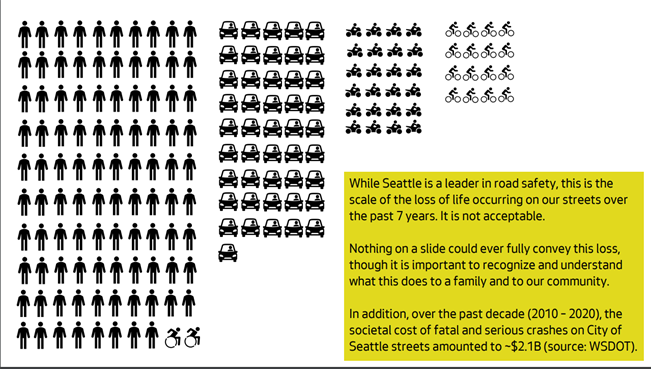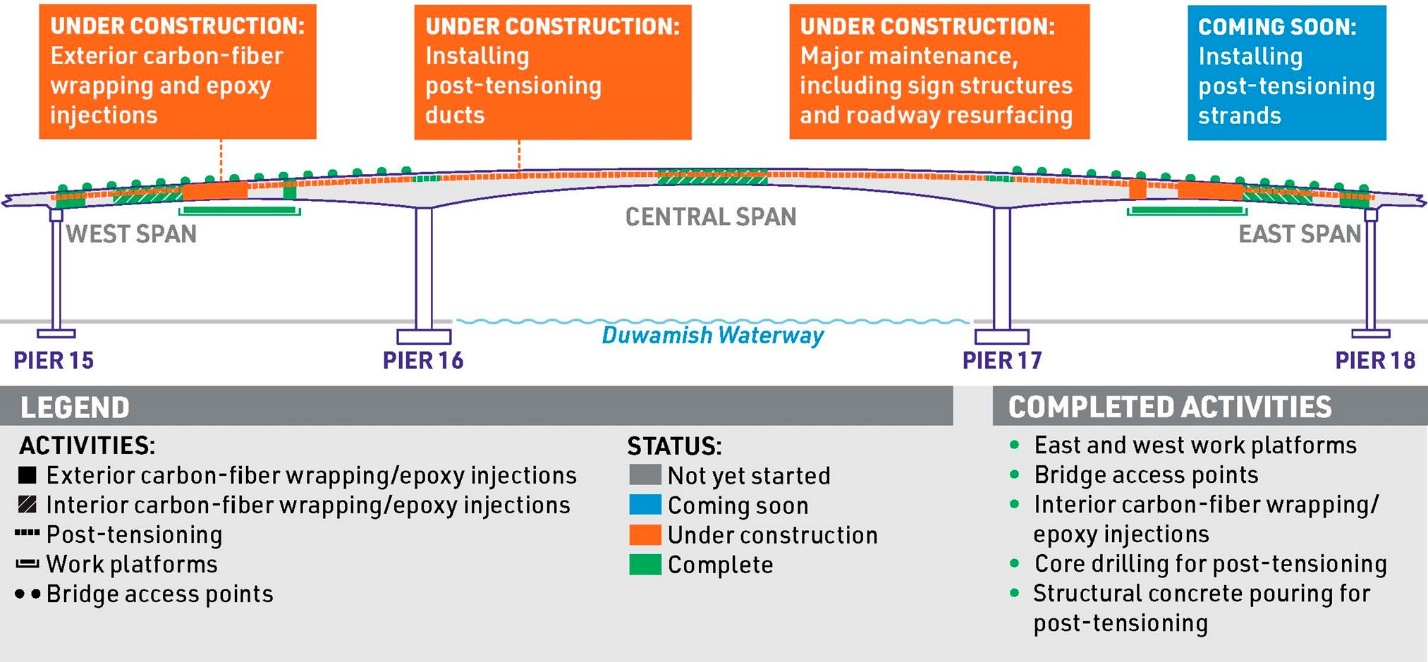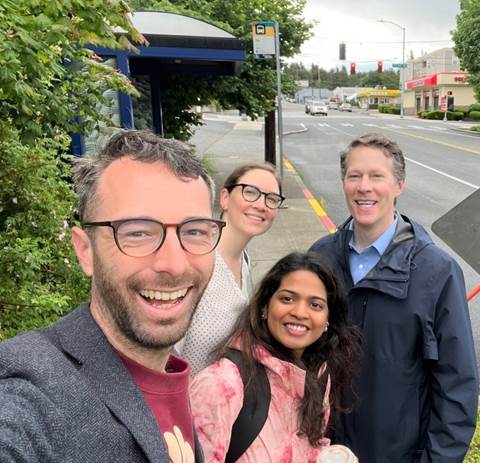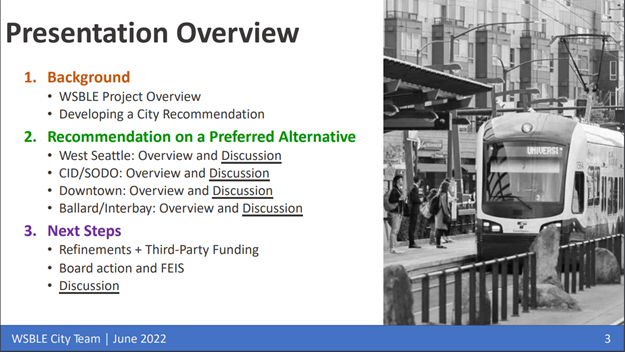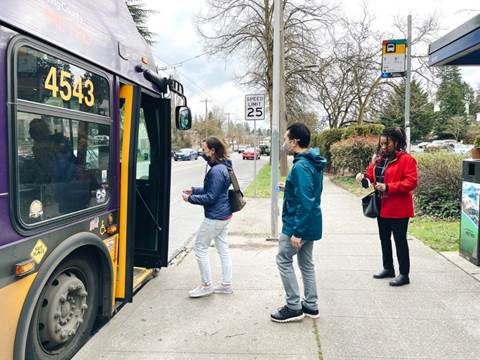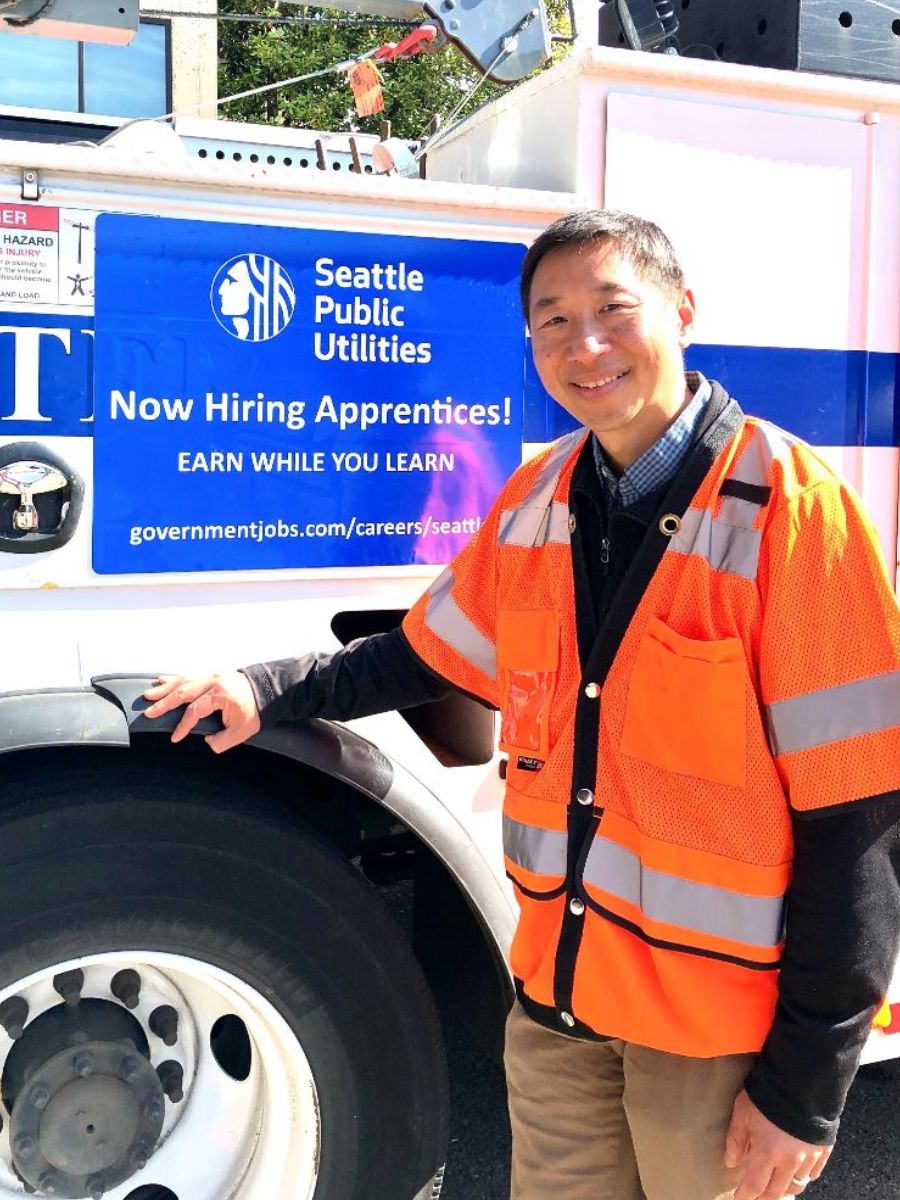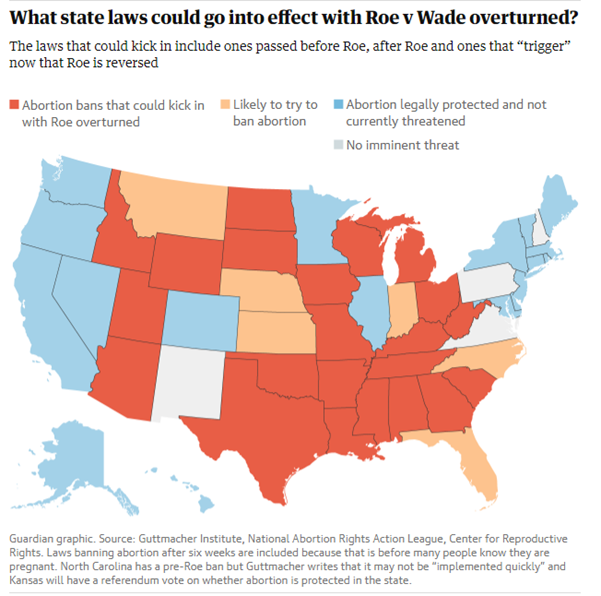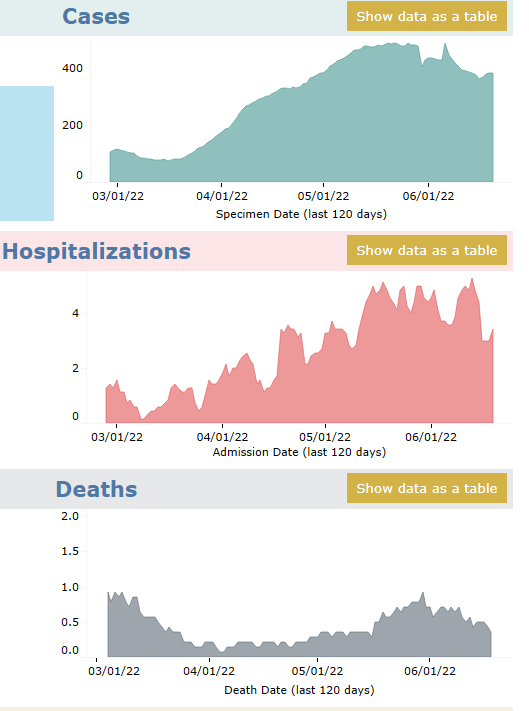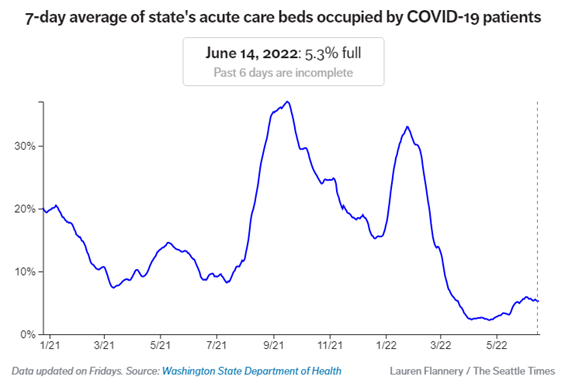June busting out with pride and no budget deficit
Friends and Neighbors,
Pride was overflowing in Seattle this past weekend as thousands were reminded of how fantastic our city can be. People were happy to be outside in the sunshine during the Seattle Pride Parade, once again enjoying the heart of their city — from City Hall to the Space Needle. Even as a District Councilmember representing Northeast Seattle, I recognize our downtown as a vital provider of jobs, generator of tax revenue, and center stage for citywide activities that welcome and benefit the entire city. It was a beautiful day to celebrate Seattle’s LGBTQ+ community. In the wake of devastating U.S. Supreme Court decisions from the other Washington, the Seattle Pride Parade helped to reaffirm how we are better as a society when we work together to solve problems and protect each other’s rights and safety.
Mayor Bruce Harrell leads our city government team at the Seattle Pride Parade this past weekend. Councilmember Pedersen marches along in solidarity, with his new shorts unofficially proclaiming the start of summer in Seattle.
In this month’s newsletter…
- District 4: Engaging in Cowen Park, Magnuson Park, Roosevelt, Sand Point, the U District, and more.
- Homelessness: Action Plan, budgets, RVs, permanent low-income housing.
- Public Safety: response times, labor contracts, police roll calls, National Night Out, and more.
- Preventing Displacement: Overriding mayor’s veto and Comprehensive Planning
- Budgets and Taxes: There’s no deficit and the proposal to double parks property tax
- Transportation & Seattle Public Utilities Committee: reducing pedestrian fatalities, West Seattle Bridge reopening date, recommendations for Sound Transit, confirming head of Seattle Public Utilities, and more
- Public Health Updates: Roe v Wade, beating the heat, meals for kids, COVID stats
- Ways to Provide Input
DISTRICT 4
Seeking Funds to Save Archives
Seattle Councilmember Alex Pedersen (left) accompanies Shayna and Ben from the team of U.S. Senator Patty Murray on a tour of the National Archives Building on Sand Point Way NE in our City Council District 4, June 17, 2022. Senator Murray is seeking $98 million in federal funds to keep these precious records in the Seattle area. (The buttons we received from the local archivists proclaim, “You don’t have to go to Washington D.C. to visit the National Archives” (photo courtesy of the City’s Office of Intergovernmental Relations).
It was a team effort among local journalists, research advocates, tribal government leaders as well as City of Seattle, State of Washington, and U.S. congressional leaders to save the precious national archives facility in Northeast Seattle from a sudden sale by federal agencies. That’s providing time to develop a plan to keep these irreplaceable historical records in the Puget Sound region.
Many have asked, what’s next? I’m happy to report that U.S. Senator Patty Murray has answered that question in a big, positive way by recently requesting up to $98 million through the “congressional directed spending process” (i.e. the newly reformed process of “earmarking” federal tax dollars directly to a project in an elected official’s jurisdiction, rather than requiring a federal agency to conduct a competitive application process). Senator Murray’s request is entitled, “NARA Sand Point Facility: To construct a new NARA facility in Seattle, Washington.” (NARA stands for National Archives & Records Administration.) There are no details yet, presumably to provide the Senator with flexibility on options. Moreover, the request needs to survive the political appropriations process that occurs in Washington, D.C. This appears to be Senator Murray’s largest ask from among her more than 150 earmark requests. This demonstrates not only the immense expense of such a capital construction / reconstruction project but also Senator Murray’s commitment to the local preservation effort, considering the persity of stakeholders that came together to “save” the archives.
Earlier this month, I accompanied key staff of Senator Patty Murray’s Seattle and D.C. offices and our City’s Office of Intergovernmental Relations (OIR) for an extensive tour of the National Archives building, which is located in District 4 on Sand Point Way NE. The tour of the warehouse areas with countless boxes piled to the ceiling reinforced the extent and value of these historical records as well as the deteriorating physical condition of the existing facility that we rely on to protect these documents. The funds sought by Senator Murray could be used to rebuild on the existing site or to build on another site in the Seattle area. Either way, the records would be preserved locally rather than making Northwest tribal governments, researchers, and others travel thousands of extra miles to view the historical records, which also include irreplaceable information about treaties, land ownership rights, and personal records. (Note: digitizing these files would take over a decade and would not include important contextual information that archivists place alongside the documents for greater understanding of their significance.)
- For a link to the funding “earmarks” requested by U.S. Senator Patty Murray, CLICK HERE.
- For details on our ongoing efforts to keep the archives in the Seattle area, CLICK HERE.
Funds Elevate Historic University Heights Building

Earlier this month, I joined State Representatives Gerry Pollet and Frank Chopp as well as our City’s Budget Chair Councilmember Mosqueda in the heart of the University District to celebrate improved equity and access that will be possible with the upcoming installation of a new elevator at the historic University Heights building. The building symbolizes community and offers childcare, artistic performances, educational opportunities, services for people experiencing homelessness, and more. The nonprofit that manages the building is finalizing its fundraising efforts which already includes money from the City Hall. In addition to their efforts to raise money for the forthcoming ADA-compliant elevator, my office secured funding to upgrade their fire alarm system to make sure the childcare facility qualifies for its State license. The uplifting event featured toddlers dancing and teenagers singing and an impressive announcement that Congresswoman Jayapal is pursuing $4.1 million in additional funding for physical improvements to the building. U Heights houses 11 organizations that serve the local community. Capital upgrades will help facilitate more than 215,000 annual visits, continue critical human services, and arts and culture programs.
15th Avenue Northeast Repaving Finally Done!
(photo by Alex Pedersen, 6/28/2022)
The repairing, repaving, and restriping of 15th Avenue NE from Lake City Way to the U District is finally done – nine months late. Thanks to so many District 4 residents for putting up with the bumps and detours and interruptions (including the concrete strike). The good news is that the positive vision is implemented: to share the road and connect more modes of travel to the light rail stations and Roosevelt High School (“safe routes to school”), while preserving some street parking at key spots. And, yes, I support these bike lanes. (Before the pandemic, I went door-to-door to ask 15th Ave NE residents their views on the proposed bike lanes there and a majority were fine with them.) This project was wisely preceded by a seismic upgrade to the aging Cowen Park Bridge. Ideally, SDOT would take this same approach by first completing a seismic upgrade of the 100-year old University Bridge when expanding the heavy use of that aging multimodal bridge with the planned boosting of bus lines down Roosevelt Way to Eastlake Ave.
101.1 FM: Radio Show “The Bridge,” with former CMs Jean Godden and Sue Donaldson
Councilmember Pedersen was honored to spend radio time with two living legends of Seattle City Council, Jean Godden and Sue Donaldson.
Last week, I visited the recording studio for 101.1 FM Radio, which is located at the entrance of Magnuson Park in District 4. Former Councilmembers Jean Godden and Sue Donaldson interviewed me for their radio show which has a great title – it’s called “The Bridge.” I answered questions about the City budget, public safety, and, of course, bridges. 101.1 FM radio has a fun variety of music and information – broadcast widely from its home in Magnuson Park, so be sure to tune in.
- Links to “The Bridge” radio show, CLICK HERE.
- Links to 101.1 FM, CLICK HERE.
- More about S.P.A.C.E. programs, with an emphasis on local art, CLICK HERE.
Community Gardens in District 4: What does that P stand for in “P-Patch”?
Councilmember Pedersen at the celebration for the growing “P-Patch” community garden at Magnuson Park, June 24, 2022.
Did you know that Seattle’s first official community garden grew here in District 4? That community garden (or “P-Patch” as we refer to it in Seattle), still thrives adjacent to University Prep School and Temple Beth Am on 25th Avenue NE at NE 80th Street.
Do you know what the “P” stands for in P-Patch? It turns out, it’s not peas, pumpkins, or pomegranates, but rather Picardo — for the small Picardo Family Farm that once flourished here between the Ravenna and Wedgwood neighborhoods. Community gardens, which started in Seattle in the 1970’s, span the globe and have been ideal to reclaim open green space in often neglected areas to grow fresh fruit and vegetables for those in need. But the volunteer gardeners, like the green thumbs at the 3-acre Magnuson Park P-Patch I visited for their celebration last week, will tell you it’s the community connections that grow the deepest roots among these garden plots. Each winter, my parents made me turn over the dirt to prep their small garden which rewarded us later with strawberries and corn in the summertime.
At the P-Patch celebration in Magnuson Park (on your left when heading to the dog park), I was joined by Greg Wong, the new Director of the Department of Neighborhoods (DON). (The P-Patch program is administered by DON). The dedicated gardeners and community organizers spoke about the initial resistance to the garden, the challenges of getting funds, the importance of visionaries and City leaders who got it all started here and the countless hours or removing rocks and broken glass from the former Naval Station land to restore the soil for the garden. A 4-year old who attends the Denise Louie high-quality child care center in Magnuson Park offered to escort us to her garden plot so she could proudly show off her lavender, pink flowers, and worms. This P-Patch supplies fresh produce to food banks throughout North Seattle, such as the food pantry at Magnuson Park for the 850 low-income residents there and for the food banks in the U District and Lake City.
- To sign up for a small garden plot, CLICK HERE.
- For the Department of Neighborhoods website with a map of the nearly 90 P-Patches in Seattle, CLICK HERE.
Roosevelt High School Ultimate Frisbee Team: 2022 State Champs!
With the end of the school year, students and parents could reflect on how so many people re-started their participation in sports, drama, music, and so many other activities. With so many accomplishments from the schools in Northeast Seattle, here is just one of the noteworthy sporting events to celebrate: Roosevelt High’s 2022 State Champs for Ultimate Frisbee. (photo from DiscNW).
ADDRESSING HOMELESSNESS
Mayor’s “Homelessness Action Plan” with Dashboards
PLAN: Just four weeks ago, Mayor Harrell put forward his plan to reduce homelessness, which relies heavily on more active engagement with illegal encampments and supporting the King County Regional Homelessness Authority.
DASHBOARDS: The dashboards are helpful summaries that will increase transparency and accountability, although the map entitled “Verified Tent and RV Encampments” does not appear to reflect the reality on the ground. That’s another reason to report encampments using the Customer Service Bureau app rather than emailing because this dashboard does not track the number of emails. The Customer Service Bureau form has options such as “Unauthorized Encampments” and “Abandoned Vehicle” (CLICK HERE). (The Customer Service Bureau database and the “Find It, Fix It” app/database are linked.)
BUDGET: Later that week, the King County Regional Homelessness Authority announced it is seeking up to $90 million ABOVE their existing budget. Of that $90 million, approximately half of that ($50 million) is a high priority for KCRHA. If the city government were to share that priority cost with King County government (as it does with KCRHA’s baseline budget), then presumably, our City would need to provide another $25 million. As with many recent news articles, it’s reported that the City has a “deficit.” Claiming there is a City budget deficit is not entirely accurate because that “deficit” is referring to only the City’s most well-known and flexible fund, the “General Fund.” But large portions of the new payroll tax revenue (JumpStart) — which has $43 million more than anticipated this year (2022) and is projected to have another $62 million more than the $233 million baseline for that revenue source in 2023 — can also be used to support people experiencing homelessness.
I look forward to seeing a detailed plan as to how KCRHA plans to enact their proposals. For example, one of their biggest requests is $5 million for “RV Safe Lots.” Like many constituents, I’ve felt some initial hesitation when remembering the City’s previous unsuccessful attempts to create RV Safe Lots. That said, I’m encouraged by KCRHA’s leadership and expertise. As we have seen from decades of attempts, reducing homelessness has no simple solution, which is why I’m encouraged by the creation of KCRHA and the work they do, because this regional problem requires a regional approach to help inpiduals meet their needs throughout King County, rather than concentrating all services within the City of Seattle.
- To see Mayor’s Harrell’s Homelessness Action Plan website, CLICK HERE.
- For the May 31, 2022 announcement of Mayor Harrell’s Homelessness Action Plan, CLICK HERE.
Addressing Derelict RVs: I appreciate the Harrell Administration’s recent efforts to intensify outreach to offer housing/services to occupants of illegally parked RVs, while also eventually enforcing parking laws. RV encampments have been prone to fire hazards and, in some cases, illicit activity. Moreover, the housing and service options offered provide great opportunity to help our neighbors get back on their feet.
Permanent Low-Income Housing:
District 4 is home to several low-income housing projects including Gossett Place and the Marion West projects built by LIHI, Abora Court built by Bellwether Housing, Mercy Magnuson built by Mercy Housing, the Solid Ground Housing at Magnuson Park, and Cedar Crossing built by both Bellwether and Mercy Housing (250 affordable apartment units opening on top of the new Roosevelt light rail station). In addition to these projects subsidized by the City of Seattle’s Office of Housing, there are projects operated by the Seattle Housing Authority. District 4 also has had substantial non-subsidized “naturally occurring affordable housing,” although much of that housing has, unfortunately, been demolished by real estate developers in areas that the City previously upzoned.
(A key purpose of Council Bill 120325, which I sponsored with Councilmember Tammy Morales, was to inventory the rents and affordability levels of all rental housing in Seattle so that we could avoid future demolitions of affordable housing. While the bill was unfortunately vetoed, you can write to Council@seattle.gov to encourage Councilmembers to override it July 5.)
The 30-unit Tiny Home Village I worked with LIHI and Sound Transit to site, fund, and build will eventually give way within the next couple of years to a permanent housing tower. To enable that to happen, the City will eventually need to approve a partial “vacation” of the alley that currently pides the parcel into two. To enable that large low-income project to move forward to create dozens of new units, I may need to introduce a special Resolution next month.
PUBLIC SAFETY
# of Officers Decrease, Police Response Times Increase
In my newsletters in April and May, I detailed the alarming reduction of officers and detectives at SPD – losing nearly 1/3 of our frontline officers and detectives, even as our city’s population has gone in the opposite direction: growing by 25% in the past 10 years — from 600,000 people in 2010 to nearly 750,000 people today. Meanwhile, we still don’t see sufficient emergency response alternatives in place yet. So it should be no surprise that it’s taken police longer to respond to violent crimes in progress (Priority 1 calls) and they are frequently unable to show up for the lowest priority calls.
I appreciated the compromise Resolution and Council Bill that Council adopted by a 6 to 3 vote on May 24, 2022 — and we need to do more.
Here are the remarks I had prepared for the Public Safety & Human Services Committee on June 14, 2022:
“Many City leaders say they want to craft policies and budgets based on the data and yet, once again, we have this disturbing data in front of our eyes: the number of police officers is dangerously down and the response times are dangerously up and this confirms what we hear from our constituents. I recently attended six different roll calls (at the start of their patrol shifts) and heard directly from public safety officers about their plummeting morale and lack of trust for several reasons: King County Jail often refuses to book the suspects SPD officers risk their lives to bring to justice and services, and City leaders aren’t doing enough to retain officers while other jurisdictions offer bonuses and simple gestures, such as allowing officers to take home their patrol cars and providing technology to keep them safe. I opposed the 50% defunding push as misguided and I introduced legislation 9 months ago to retain police officers, but several colleagues rejected it. Recruiting new officers to replace the hundreds of officers departing Seattle is vital, but that takes a long time and ignores the experience of our existing officers, so I am hopeful Mayor Harrell’s public safety plan coming soon also includes immediate and robust retention actions to prevent Seattle from losing more officers.”
— City Councilmember Alex Pedersen
- For the Response Time Report for 1st Quarter 2022, CLICK HERE.
- To apply to be a Seattle police officer, CLICK HERE.
- For the Seattle Times May 20 editorial entitled, Mayor Harrell, stem the blue drain with Seattle Police Department hiring incentives,” CLICK HERE.
Inquest into the Police Killing of Charleena Lyles
The overdue inquest received an identification number from King County (517IQ9301), but she was a person, a mom, a District 4 resident, and much more: Charleena Lyles, who was killed by two Seattle Police officers in her Magnuson Park apartment 2017. I supported the more robust inquest process put in place by King County Executive Dow Constantine, which he reformed for additional transparency in researching presenting the facts of fatal police shootings. For some of the news coverage of the inquest, you can see the Seattle Times coverage HERE (June 21), HERE (June 22), HERE (June 28) and HERE (June 29). This is a tragic example of why Seattle needs to launch alternative emergency responses for some behavioral health situations, which we urged at our Public Safety & Human Services Committee on June 28 (CLICK HERE for that Committee video).
Reforms Deepened Through New Police Contract with Lieutenants and Captains
The City Council and Mayor approved a new employment contract between the City of Seattle and the Seattle Police Management Association (SPMA) which represents the lieutenants and captains of the Seattle Police Department (SPD). The contract creates a better system to address disciplinary appeals and takes other critical steps to strengthen accountability processes and improve public safety. While it covers only the 80 lieutenants and captains of SPD, this contract historically serves as a model for the much bigger contract with the Seattle Police Officers Guild (SPOG), which represents frontline officers and sergeants.
I continue to believe that the key to deeper and sustainable reforms is to embed them into these employment contracts which govern police misconduct appeals and other related issues. Simply taking money away from the police department does not make it more accountable and in fact stresses the day-to-day operations (see Longer Response Times discussion above) and stresses the officers as human beings, exhausted from working approximately double the number of overtime hours.
As the Central Staff memo confirms, “The proposed CBA would make changes to existing police accountability provisions, including the addition of a new Discipline Review system that would significantly overhaul appeals that are currently settled through arbitration.”
As our Public Safety Chair, Lisa Herbold said, “This contract addresses key flaws in prior police contracts. In particular, this contract will help fix Seattle’s broken disciplinary appeals system. Right now, nearly 100 cases of police misconduct, some dating back to 2016, are being appealed – a backlog that continues to delay and deny justice. This new contract takes a crucial step toward ending that backlog while ensuring police officers who commit misconduct are held accountable.”
As noted in the press release, the contract creates a new process to govern prospective disciplinary appeals through a model that is fair and reliable – leading with transparency, providing due process for employees, and putting in place key measures to ensure discipline is actionable and upheld as warranted. Provisions of this enhanced system include:
- Applying a consistent standard for misconduct findings and appeals (not more onerous than a “preponderance of evidence”)
- Giving significant deference to the findings and disciplinary decisions issued by the Chief of Police
- Preventing new evidence not previously disclosed from being introduced on appeal
- Increasing the independence and neutrality of those who hear appeals
- Making disciplinary appeals hearings more transparent and accessible to the public
For the joint press release from Mayor Harrell and Public Safety Chair Herbold, CLICK HERE.
For Council Bill 120332 that authorized the contract CLICK HERE and for the Central Staff memo analyzing it, CLICK HERE.
To read the entire 76-page labor contract (“collective bargaining agreement”) with SPMA, CLICK HERE.
Visits to Police Roll Calls
It was one year ago on June 13th, 2021 when our City government lost a co-worker — SPD Officer Lexi Harris was struck and killed by a vehicle on I-5 while trying to help others involved in an earlier collision. Some of Lexi’s family still reside in the Wallingford neighborhood. I know so many people miss Lexi’s “Wonder Woman” strength and spirit as well as her compassionate commitment to the wellness of her fellow officers and to the safety of everyone in our city.
Earlier this month, I attended six roll calls of the Seattle Police Department’s North Precinct, including the ones starting at 3:00 a.m. and 3:30 a.m. (as I did in August 2021 as well). I let the officers know that I appreciate the good work these frontline City employees do for our residents and neighborhood businesses, and I encouraged them to stay with Seattle. As I have mentioned repeatedly, I am very concerned about the policing staffing crisis after having lost more than 300 officers and detectives over the past 2 ½ years. No other City department has lost more than 1/3 of its frontline workers and, for a department needed for a holistic approach to public safety, I believe this warrants special attention. Based on what I heard firsthand at these rollcalls, a lot of work needs to be done to rebuild trust. I’m afraid this attrition of officers AND detectives will be much worse next month because of a new State law (SHB 1701). Unfortunately, that new State law financially incentivizes officers eligible for retirement to retire by July 1, 2022 before a special benefit expires.
I look forward to Mayor Harrell’s forthcoming safety plan, which hopefully includes a compelling strategy for not only recruiting but also retaining our experienced officers. We need to refocus our efforts on retention – we need to retain highly trained officers because recruiting takes such a long time and we are losing many more officers than we are recruiting.
National Night Out
“Night Out” is a national event on Tuesday evening, August 2, 2022 for neighbors to enjoy time together on side streets in their community to connect and share food while heightening crime prevention awareness. To register your block for the event or to find an even near you for National Night Out, CLICK HERE. For more immediate crime prevention needs, contact a Crime Prevention Coordinator by CLICKING HERE. I worked hard to secure funding for two Crime Prevention Coordinators in North Seattle: Sarah and Katelyn are already hired and ready to meet with you to share crime prevention tips.
Seattle Police Department Facebook page
Being a police officer is a tough job and, rightfully, receives a lot of scrutiny and critique. Our Seattle Police Department also occasionally shares good news, which is found mainly on its Facebook page: https://www.facebook.com/SeattlePolice
ECONOMIC DISPLACEMENT AND LAND USE/ZONING
Call to Action!
##BUTTON
Additional Reasons to Override Mayor’s Veto of Council Bill 120325 on July 5
In last month’s newsletter, I discussed how the inexcusable and stubborn lack of data about Seattle’s changing housing inventory as well as careless increases in property taxes can fuel the displacement of vulnerable residents, including low-income renters and seniors on fixed incomes.
On May 31, 2022, a majority of the City Council approved Council Bill 120325 to collect basic rental data City Hall has been lacking for years – data we need urgently now, on the eve of considering massive land use / zoning changes through a required “Comprehensive Plan.”
As one of the sponsors of the bill, I outlined several reasons to support the bill and you can read about them on my blog by CLICKING HERE. Here are those initial reasons in favor:
- WE NEED THIS DATA TO PREVENT DISPLACEMENT
- THIS DATA IS VITAL BEFORE COUNCIL MAKES CHANGES TO THE COMP PLAN
- CURRENT CENSUS TRACT DATA AND RENTAL SURVEYS ON VACANT UNITS LACK VITAL DETAILS
- WE HAVE ALREADY CONSIDERED ALTERNATIVES
- DATA CAN VALIDATE AFFORDABLE BENEFITS OF SMALLER “MOM & POP” LANDLORDS
In deference to landlords who expressed concerns about the concept, the bill included important accommodations:
- THIRD PARTY: A RESEARCH UNIVERSITY WOULD RECEIVE THE RAW RENTAL DATA INSTEAD OF THE CITY GOVERNMENT.
- TEMPORARY: THE REQUIREMENT WOULD SUNSET IN 3 YEARS.
Opponents of this bill to collect and analyze data also raised concerns of control and cost. So we amended the bill further:
- THE CITY’S EXECUTIVE DEPARTMENTS WOULD BE IN THE DRIVER’S SEAT: Nothing happens until the Executive executes a contract with the research university after the competitive Request for Proposals (RFP) and the RFP can manage the costs. Specifically, the bill adopted by Council now states, “effective three months from the date the contract described in subsection 22.214.055.C is executed, the information described in Section 22.214.055 shall be submitted by the owner at least twice annually…”
Between the Mayor’s Veto and Council’s reconsideration, I offer these additional supports for the bill and urge at least one of the four Councilmembers who voted against it to join the majority so the bill becomes law:
- RENT REGISTRIES ARE INCREASINGLY COMMON IN THE U.S. (Seattle is way behind; we are NOT progressive): Long-standing laws requiring rent rolls already exist in older cities, such as New York City. Moreover, many California cities have implemented programs over the past few years (and a bill is pending in the California State Legislature to require them state-wide). A 2019 report examined 8 rental housing registry programs, including 3 that already require the rent amount to be provided. A more recent February 2022 news article highlighted 16 different cities in California which are not waiting for their State legislature to act. Notably, Oakland states that a purpose of their program is to “provide data that can be used to inform future housing policies.”
- COSTS ARE DRAMATICALLY LOWER THAN SEATTLE OPPONENTS CLAIMED. Based on (1) the actual experiences of these other cities, (2) the fact that we are adding onto an existing housing registry (Seattle’s Rental Registration & Inspection Ordinance) that already enforces the collection of data, and (3) we would be using a competitive Request for Proposals, the cost to add the collection and research components of CB 120325 would be between $125,000 and $425,000 in 2023 with a grand total of only $375,000 to $675,000 over the 3 years of the program. Basically $125,000 per year for university researchers and approximately $300,000 for startup software /tech support — if the university did not already have such software. Moreover, the two departments that should want this data (OPCD and SDCI) received a budget increase last year and the Executive departments should be doing this work as they prepare for the Comprehensive Plan anyway. The university – chosen via a competitive RFP – would be doing the data entry, sorting, mapping, and analysis. The best university would not need to buy a new database system, but would already have the technological capabilities which, frankly, is not rocket science.
- The high $2 million estimate from the Executive was for the entire 3-year period (actually, only $667,000 per year). This amount was in the 2nd and final version of the Fiscal Note and relied on the executive/UW, rather than actual data from other cities: “OPCD discussions with the University of Washington estimated costs for a contract for this project to be a minimum of $2 million, including $600,000 for database setup, $430,000 a year for staffing ($1.29 million over three years), workspace rental, and overhead.” Relying on the cost estimates from an organization that wants to be paid for the work rather than seeing how the work is already done in other cities is inadequate.
- The highly questionable $5 million estimate should be disregarded. It originated from an un-authored document provided by Central Staff to Committee members May 19, 2022 entitled “SDCI, OPCD, and OH Comments on Council Bill 120325”. That doc said, “We anticipate it will be costly for a research university to set up and administer the program. It will be somewhat comparable to the RRIO registration system, the startup costs for which were approximately five million dollars.” The City Council’s Central Staff prudently did NOT include that exaggerated figure in Fiscal Note, but it nevertheless made it into the remarks of some opponents. The figure makes no sense because CB 120325 was an efficient add-on to the existing RRIO unit registry system. To claim that adding a few bits of data would cost as much as setting up the original system is illogical.
Alternatives on Funding:
Seattle department(s) responsible for this work (SDCI and OPCD) recently received budget increases and should be able to absorb these costs. Again, due to amendments adopted May 31, the Executive can control how much is provided to a research university selected via a competitive RFP. But, if the Executive found that the existing budget cannot handle the data requirements needed to analyze displacement risks as already required by City policies (listed in the Whereas recitals of CB 120325), there are additional options:
_ Increase Fees (not Council’s recommendation): the City could simply increase the RRIO fee paid by landlords already, per SMC 22.900H. Hypothetically, for the City’s 150,000 units registered with RRIO a per unit incremental increase of just $4, on average, would generate approximately $600,000 – essentially the landlord paying the cost of a latte for each unit. (Note: the landlord RRIO fee is paid every two years.) This was not Council’s recommendation, but it gives the Executive yet another option with additional flexibility. (See existing RRIO website for current fees.)
_ Consider JumpStart Tax eligibility (not Council’s recommendation): In adopting what is known as the JumpStart payroll tax spending plan, Section 1(B)(2)(a) of Resolution 31957 which we adopted in 2020, the Council explicitly requested that a portion of the JumpStart money be allocated to “programs designed to… preserve naturally occurring, quality, affordable housing, and examine the role that smaller landlords may play in providing safe, affordable housing.” What City Council adopted with CB 120325 can be considered just such a program, intended to develop exactly the data and analysis need by the Council to develop effective policies that meet the objectives of the JumpStart resolution. As we know from the most recent revenue forecast, the revenue from JumpStart is coming in much higher than anticipated. Reading from the April 8, 2022 press release, “JumpStart Seattle is now projected to bring in more than $277 million in 2022, which is $43.6 million beyond what was expected last November.” Again, this was not Council’s recommendation, but it’s important to point out that the City is technically not lacking funds for such a low-cost data collection and analysis operation necessary to understand how and where to prevent displacement as already required by City policies.
The bottom line is that there are plenty of reasons to support Council Bill 120325 as the majority already did and the reasons against it are not based on solid information.
CALL TO ACTION: To urge Councilmembers to override the Mayor’s veto, click the button below:
##button
How to Participate in Comprehensive Plan Update;
Scoping Comments Due July 25
In response to the inevitability of growth and change, most cities now plan for their future. What will we need in terms of housing, transportation, jobs? Will we have enough water, electricity, parks and open space, fire protection, wastewater treatment infrastructure, and other services? These issues and more are now required to be addressed in long range “comprehensive plans” by cities and counties in Washington State under the Growth Management Act (GMA). First adopted in 1990, the GMA has been amended numerous times to add new issues to consider, such as low income “affordable” housing and recently climate change (CLICK HERE). The Municipal Research and Services Center (MRSC) has a summary of GMA requirements HERE.
Comprehensive planning affects the daily lives of everyone who lives, works, or visits our city. Plans determine where new housing is likely to be built, where transit service is to be increased, and where new community centers, fire stations, and utilities will be built. Over time, the plan will help determine the look and feel of the city. How the city plans for growth can even determine if inpiduals, families, and communities will be able to stay in the city; physical and economic displacement is an increasingly important concern and focus of city planning.
Seattle’s current comprehensive plan—“Seattle 2035”—was initially adopted in 2016, and policymakers update it with amendments annually. All of the current plan documents are HERE. Increasing inequity of wealth and income in Seattle (and the U.S.) has resulted in displacement being a vital component of our comprehensive planning. Extensive City resources have been committed to addressing displacement through an Equitable Development Initiative (EDI) adopted as part of the 2016 plan. The EDI has its own resource page, HERE. The City uses the EDI to address displacement by allocating funds toward the construction of more affordable housing. An inherent shortcoming of the EDI is that it typically tries to offset displacement after the damage is done. Ideally, the City would also utilize land use policies to protect existing affordable housing from demolition / redevelopment to prevent displacement, or to require direct and immediate mitigation for the loss of existing affordable housing.
One of the most important prerequisites to good planning is good data. Regarding the critical issues of affordable housing and displacement, I advocated for City collection of more information on the cost of housing, including how much rent people pay in different kinds of housing and different parts of the City. These questions came to a head recently in the Council’s passage of Council Bill 120325 that would require gathering of rent roll data city wide. CB 120325 passed the Council but was vetoed by the mayor. You can read more about this issue HERE.
Every few years the City is required to update its Comprehensive Plan; the City is required to prepare and adopt its next new plan by 2024. Since it takes about two years to prepare a new comprehensive plan and accompanying environmental review of this scope, the City has already started to prepare its new “One Seattle Plan.” The responsible City Office of Planning and Community Development (OPCD) has set up a new page for this work, HERE. An important early part of the development of the plan—called “scoping”—is now open from June 23 through July 25, 2022. The formal “Scoping Notice” is HERE.
Scoping is an early part of the environmental review required under the State Environmental Policy Act (SEPA). OPCD has already determined—appropriately—that a full environmental impact statement (EIS) will be prepared, including evaluation of alternatives for dealing with the City’s likely future growth and change. OPCD’s description of “One Seattle Plan” SEPA scoping—called “Shaping the Plan”—is to enable Seattle’s residents and others to “help determine what we should study—which topics are important to you and your community, and how you want Seattle to shape its growth.” OPCD has also already framed “draft alternatives” it plans to explore in the EIS for the One Seattle Plan, HERE.
To watch OPCD’s short video about the Comprehensive Plan process, CLICK HERE.
An understanding of the scope of OPCD’s planning and the assumptions going into the comprehensive planning process will help you determine what you tell the City should be included in the plan, or which City assumptions you think are not accurate. The May 11, 2022 presentation to the Council’s Land Use Committee and series of “Issue Briefs” at the top of the “Documents Page” HERE are informative.
If you want to influence how OPCD assesses the impacts of the alternatives it has chosen, or even challenge the underlying assumptions driving those choices, now is your chance. For example, their Displacement” section states, “Preventing displacement is a major goal of the Comprehensive Plan Update.” That’s good, but then it does not provide any anti-demolition policies or immediate mitigation (such as 1 for 1 replacement of demolished low-income units).
OPCD has a page dedicated to scoping input HERE. You may also send your scoping comments to: brennon.staley@seattle.gov. In addition to the scoping comment period ending on July 25, OPCD has created other ways to participate, with the main “Get Involved” page HERE. On that page you will find notices of meetings, including one on Tuesday evening, July 14 about scoping before the comment deadline (CLICK HERE).
BUDGETS and TAXES
No Budget Deficit
Here’s the bottom line: There is no budget deficit in city government.
Columnist Danny Westneat captures this accurately in his column (CLICK HERE). He writes correctly, “Seattle is still dealing with general fund deficits, from both the pandemic and new spending programs. But Seattle’s deficit isn’t really a full-on deficit, as it doesn’t include the JumpStart revenues. Those are in a separate fund, earmarked for specific programs. That fund is raking in surplus revenues, far beyond what was expected. If you count that surplus, Seattle is in the black. (This is how Seattle could fix its immediate budget problems – just tap the JumpStart fund).”
In essence, a simple amendment to increase flexibility for how we use JumpStart tax revenues would enable us to plug the General Fund gap and still provide ample dollars for JumpStart’s important goals.
Here are some of the sources of information:
From the April 20, 2022 presentation by the City Budget Office, page 9:
City Officials Want to Double Your Property Tax for City Parks: Is the Increase Justified?
Seattle loves its parks and recreation centers and yet many of us were unable to enjoy them during the first two years of the pandemic, due to closures and due to the homelessness crisis. The original six-year plan that funds and guides part of our Parks and Rec system is ready for an update this year.
Last week all nine of your City Councilmembers assembled as members of the Parks District Board for the City of Seattle. What I consider to be the headline of the long presentation was buried on slide 25 of the one of the two presentations: The Parks Department and the volunteer Parks commissioners are pushing a proposal to double the portion of the property tax you pay to supplement 20% of our city’s parks and recreation facilities and programs.
I appreciated the questioning from our new head of the Board (Councilmember Andrew Lewis) regarding what appears to be a proposal to increase your property taxes by $10 million through the Parks measure and pert that funding to our City’s General Fund. It’s labeled as “COVID-19 / Economic Recovery.” As already established above, there is no City budget deficit when we look at all the City’s funds and we are finally emerging from the COVID pandemic. So raising your future property taxes from the Parks measure and then diverting your tax dollars is not fiscally responsible – it’s neither necessary, nor fair to you. Continuing the existing funding, raising by an inflation factor, and funding the “pre-commitment” items make sense to me. Diverting money to the General Fund and some of the new program should be carefully scrutinized. This is vital not just within the context of fiscal prudence for Parks but also because multiple property tax levy increases are coming your way: affordable housing, transportation, and education (taxes for libraries were already increased in 2019). These are all worthy causes deserving close examination, so that we prioritize what the City truly needs. At the same time, policymakers must be mindful of the cumulative impact to your property tax bill, especially for seniors struggling on fixed incomes and because landlords can pass these costs onto renters.
CLICK HERE to watch the video and hear my comments at the June 24, 2022 Parks District Board meeting HERE and HERE. You’ll see I’m questioning the cost and taxes.
- For the agenda and presentations at the June 24, 2022 meeting, CLICK HERE.
- For the presentation by the City Council’s Central Staff, CLICK HERE.
- For the main website of the Parks District, CLICK HERE.
- For a recent Seattle Times editorial lamenting the unfulfilled promise to main our parks entitled “Seattle parks maintenance has gone down the toilet,” CLICK HERE.
TRANSPORTATION & SEATTLE PUBLIC UTILITIES COMMITTEE
(This is the Committee currently chaired by Councilmember Pedersen, so we provide extra information on its issues.)
Vision Zero: Traffic Safety
Seattle’s official policy on traffic-related safety is “Vision Zero,” which strives for zero traffic deaths and serious injuries by 2030. I asked the Vision Zero team of our Seattle Department of Transportation (SDOT) to return to our Transportation Committee earlier this month to discuss their strategies for reducing fatalities and injuries on Seattle’s streets. In 2021, there were 30 traffic-related fatalities: 19 pedestrians were killed, 7 people in vehicles or motorcycles, and 4 bicyclists. Since 2016, an average of 13% of the victims were experiencing homelessness, but in 2021 (and for the first quarter of 2022) that percentage doubled to 26% on average. Another urgent reason to bring more people inside, faster. While there have been 11 traffic-related fatalities as of June 21, 2022, each life is precious and the summer months often yield a higher number of collisions, so the overall trend is deeply troubling.
While seven of the nine City Councilmembers represent a geographic district (1/7 of the City), we each chair a Committee with citywide responsibilities. I represent Northeast Seattle AND I chair the Transportation & Seattle Public Utilities Committee (which actually has a regional footprint). I mention this because recent data on traffic fatalities confirms a disproportionate percentage of them occurring in South Seattle. So I joined with Councilmember Tammy Morales (District 2) to call for more transportation safety investments in her district in South Seattle, which includes many wide arterials with industrial uses.
“Safety must be the priority for everyone using Seattle’s roads and, unfortunately, the first part of 2022 continues the disturbing national trend of unacceptably high numbers of traffic-related injuries and deaths, especially among pedestrians and people experiencing homelessness in South Seattle.
While we have lowered speed limits, expanded access to mass transit, and increased crosswalks, we must also respond to the drop in police enforcement by increasing use of speed cameras and fines based on ability to pay, and we must reduce the traffic-related harms to people experiencing homelessness by having City departments redouble efforts to bring more people inside faster.
While I’m hopeful the City Council’s additional investments for pedestrian safety in South Seattle will reduce injuries once SDOT finishes those projects, today’s initial 2022 data sounds the alarm that the Mayor’s upcoming budget proposal must continue to increase our investments in South Seattle and other underinvested areas, so that our transportation infrastructure is quickly made safer.”
— Alex Pedersen, Chair of the Transportation Committee
For me, the theme is safety: increasing safety investments for pedestrians (by far the most at-risk mode of getting around town) is aligned with increasing the safety of our aging multimodal bridges which we rely upon for the mass transit of our bus system and even for pedestrians, as we see on our University Bridge connecting Roosevelt to Eastlake/downtown as well as on NE 45th Street I-5 overpass connecting Wallingford with the U District.
- For remarks from Councilmember Morales (South Seattle) and me, CLICK HERE.
- For the June 21, 2022 Vision Zero presentation by SDOT, CLICK HERE.
- For SDOT’s Vision Zero website, CLICK HERE.
It’s a Date! West Seattle Bridge Scheduled to Re-Open Week of September 12, 2022
Our Seattle Department of Transportation announced the promising news, but with frustrating, yet understandable caveats: “The West Seattle Bridge is scheduled to reopen as soon as the week of September 12, 2022, though a project of this scale might encounter unforeseen challenges. This schedule update comes after a series of successful milestones, including the final structural concrete pour inside the bridge in late May.”
June was “Ride Transit Month,” but Keep it Going
Kirk, Sarah, and Priyadharshini from the nonprofit Commute Seattle join Councilmember Pedersen on his morning commute by bus and light rail from Northeast Seattle to City Hall downtown during “Ride Transit Month.”
In District 4 earlier this month, I enjoyed commuting to work with advocates from the organization Commute Seattle, including their new Executive Director. As we know, June was “Ride Transit Month” and they joined me for my commute from my neighborhood down to City Hall by bus, light rail, and steps — lots of steps. After navigating the temporarily relocated bus stops and the broken escalators and elevators at Pioneer Square station, we still had fun, saved money, and avoided the rush hour traffic on I-5. Commute Seattle works with employers – both large and small businesses as well as nonprofits – to show them the financial, environmental, and other benefits of commuting to work in ways other than single occupancy vehicles.
- For King County Metro bus trip planner, CLICK HERE.
- For Sound Transit light rail routes, CLICK HERE.
- For a recommend public transit app called “One Bus Away,” CLICK HERE.
- For Commute Seattle, CLICK HERE.
Sound Transit Expansion: Suggestions from Seattle:
There are lots of decisions for the 18-member Sound Transit board to make over the next two months on how best to expand light rail system, including the 9 segments of the West-Seattle Ballard Link Extension (WSBLE). From the options in the Draft Environmental Impact Statement (DEIS), they will decide their “preferred alternatives” to study for the final EIS. Rather than sitting back and letting more than a dozen policymakers from outside of our City decide what’s best for us, the executive departments and City Council are working together on a joint Resolution 32055 to strongly voice our Seattle consensus while also supporting the regional approach of Mayor Harrell and Council President Juarez who serve on the Sound Transit board.
Seattle is arguably the biggest supporter of Sound Transit and the crucial linchpin for the entire regional system. Doing right by Seattle will speed implementation (construction permitting, etc.) that will help the entire regional transportation system come online faster.
Schedule for our Seattle Resolution for Sound Transit Decisions:
- Feb 15: Sound Transit presents at Committee draft options on routes and stations from DEIS.
- April 19: Sound Transit and City’s executive team present at Committee with more details on options.
- May 31: Mayor’s draft of Reso for Council’s Introduction & Referral Calendar.
- June 7: 1st discussion of Reso at Committee.
- July 5 (scheduled): 2nd discussion, amendments, and vote on Reso at Committee.
- July 12, 19, 26, or other date t.b.d. by City Council President: adoption of Reso by Council.
- July 14: Sound Transit Expansion Committee.
- July 28 (subject to change): Sound Transit 18-member Board of Directors meeting.
For Sound Transit expansion info, CLICK HERE.
Sound Transit Repairs “Future Ready”:
Sound Transit updated their announcement June 21 on their repair schedule for this summer and fall:
“Preparations continue for significant Link light rail maintenance activities beginning July 11, with periods when passengers will need to allow more time for trips as Sound Transit gets ready to open major light rail expansions. Completing these “Future Ready” projects before the Link system more than doubles in length from 26 to 58 miles within the next few years will prevent impacts to far greater numbers of passengers…In preparation for the upcoming work, passengers should sign up for Rider Alerts to make sure they receive further information as it becomes available…On July 11, one side of the tracks through Seattle’s Rainier Valley will close for two weeks to enable platform work at Columbia City Station. The work involves removing platform tiles and mortar and rebuilding a concrete base to ensure new tiles offer good durability, eliminating tripping hazards and safety risks from cracking tiles…The 20-minute train frequencies that were previously announced to be systemwide during work will now only apply between [downtown/SODO] Stadium and Angle Lake stations. Sound Transit will instead strive to maintain 10-minute frequencies between [downtown/SODO] Stadium and Northgate stations. “
To be immediately “Future Ready,” Sound Transit also knows it needs to fix all its broken escalators and to keep its stairwells clean and inviting!
Seattle Transit Measure (aka Seattle Transportation Benefit District)
Thanks to the generosity of Seattle voters (with a whopping 80% approval in November 2020) and everyone paying sales tax, Seattle continues to boost bus service through its ”Seattle Transit Measure“ (also known as the Seattle Transportation Benefit District or STBD). The annual report covering the middle of 2020 through December 2021 is available by CLICKING HERE. The bottom line is that bus ridership plummeted during the pandemic (see line graph above), but King County Metro kept many key bus lines running because many people have no choice but to ride transit, and the buses humming along served as a beacon of hope/activity/reliability during a bleak, uncertain time. We are appreciative of the bus drivers for keeping things moving and we are confident many more riders will continue to return to this environmentally friendly form of getting around the region.
For SDOT’s website on the Seattle Transit Measure, CLICK HERE.
For CM Pedersen’s website detailing his Committee’s 2020 renewal of this bus transit measure, CLICK HERE.
“Seattle Transportation Plan” Wants to Hear from You!
We are creating a holistic “Seattle Transportation Plan” (STP) to reconcile all modes of transportation that have been recently handled in fragmented, competing silos. Per SDOT, “The STP is our commitment to building a transportation system that provides everyone with access to safe, efficient, and affordable options to reach places and opportunities. The STP will guide local transportation investments for the next 20 years – so we want to hear from you! Our transportation system is more than just roads. It includes sidewalks, bridges, stairways, transit, paths and trails, bike lanes, crosswalks, public spaces like street cafes and benches, and much more.
To provide your input on the new Seattle Transportation Plan, CLICK HERE.
Head of Seattle Public Utilities Confirmed
At our City Council meeting on June 28, 2022, we unanimously confirmed Mayor Harrell’s nomination of Andrew Lee as the General Manager and CEO of the Seattle Public Utilities (SPU), a $1.3 billion enterprise that delivers clean water and takes away wastewater and solid waste. Mr. Lee has been ably serving as the interim head of SPU after the previous leader, Mami Hara, departed near the end of the Durkan Administration last Fall. I look forward to a continued focus on trying to keep utility bill increases to a minimum and on finishing the mega project for Ship Canal Water Quality Control on time and within budget.
A key role of City Council, under the “checks & balances” system of our City Charter, is to consider and confirm (or reject) a Mayor’s nominations to head the most important departments. The Mayor is currently conducting a national search for a new director for the Seattle Department of Transportation (SDOT), which will also go through our committee. The nomination and approval process should follow Resolution 31868.
Utility Bill Scams: Warning (again)
As Seattle Public Utilities and Seattle City Light and work to inform customers about resources available to help with utility bills, there has been an increase in scam reports of people posing as representatives of the City.
Please know that Seattle City Light and Seattle Public Utilities will NOT call customers to demand immediate payment or personal financial information. If someone calls demanding payment, rather than working with you to establish a payment plan, that is a scam. Customers who believe they’ve been contacted by a scammer should call (206) 684-3000 to verify their account.
If you or someone you know is behind on utility bills, please know that resources are available. Learn more about short- and long-term payment plans available to all customers. Income-eligible residential customers may also qualify for bill assistance programs.
For more info from Seattle Public Utilities, CLICK HERE.
PUBLIC HEALTH
Devastating Decision by U.S. Supreme Court Overturns 50-Year Roe v. Wade Precedent
Source of U.S. map: https://www.theguardian.com/world/2022/jun/24/abortion-laws-by-state-map-clinics
Because the U.S. Supreme Court decision last week relegated policies on abortion to the States, the views of your Washington State government officials will be paramount. For statements from Governor Jay Inslee, CLICK HERE and HERE. Along with your Seattle Mayor and all nine City Councilmembers, the four State Representatives and two State Senators who represent the 43rd and 46th Legislative Districts (LDs) that overlap with our City Council District 4 are all pro-choice. Laws are already in place protecting reproductive freedom of choice in Washington State. But laws can change, so maintaining a majority of legislators who support existing rights in Washington State will become vital. For my statement and the statements of other City Councilmembers, CLICK HERE and for Mayor Harrell’s statement, CLICK HERE.
Beat the Heat: Cooling Centers and Trees
Earlier this week, the temperature in Seattle reached 90 degrees, a hot reminder that our city government needs to circulate updated locations for its cooling centers.
Last fall, I secured funding for a cooling center at the Northeast branch of the Seattle Library and so I look forward to the Harrell Administration, City Budget Office, and library leadership proceeding expeditiously to upgrade that facility before the next unbearable heat wave.
I have also asked the City’s Parks Department and Office of Emergency Management to make sure Building 406 at Magnuson Park (formerly known as “The Brig”) is available as a cooling center as we still await the reopening of community centers in the area.
The heat waves reinforce the urgency of passing legislation to protect our City’s dwindling tree canopy because trees help to cool communities and homes. The legislation we crafted to register tree cutters / arborists was just a small, first step. To more systematically protect our urban forest, we need to overhaul the weak comprehensive bill introduced by the Seattle Department of Construction & Inspection (SDCI) written during the Durkan Administration. For more on protecting trees, CLICK HERE.
For a Seattle Times article, “How to stay cool during Seattle’s first heat wave of the year,” CLICK HERE.
Food Security for the Summer
The Summer Food Service Program (SFSP), also known as the Summer Meals Program, strives to provide our young neighbors in need with nutritious meals during the summer months when school is not in session. For more about the Children and Youth Summer Food Service Program, CLICK HERE.
Also, our City Council District 4 has several food banks including the U District Food Bank (adjacent to the U District Library), a weekly food pantry at the Mercy Magnuson low-income housing project at Magnuson Park, and the Family Works food bank adjacent to the Wallingford Library.
COVID Cases Higher in June than March/April, but on Decline; and Fewer Hospital Beds Used
For the latest official data from King County Public Health, CLICK HERE or use this website: https://kingcounty.gov/depts/health/covid-19/data/daily-summary.aspx
Thanks, in large part, to our relatively high vaccination rate, COVID cases and hospitalizations in Seattle continue to remain manageable. (This snapshot was as of last week for the city of Seattle.)
For the latest COVID pandemic coverage from the Seattle Times, CLICK HERE.
- To register to receive the vaccine or booster in Seattle, CLICK HERE. Information is also available in Amharic, Chinese, Korean, Somali, Spanish, and Vietnamese.
- For the most recent information on combating COVID from King County Public Health, CLICK HERE.
- If you need language interpretation, help finding a vaccination or testing site, or ADA accommodation, call the King County COVID-19 Call Center at 206-477-3977, 8:00 a.m. to 7:00 p.m.
WE WANT TO HEAR FROM YOU:
Ways to Provide Input
City Council Meetings back in person (and still on the internet)!
Now you can listen, view, and comment at City Council meetings both in person or online. Our City Council meetings are Tuesdays starting at 2:00 p.m.
Listening and Viewing: To view and listen to the meeting on your computer, CLICK HERE for Seattle Channel.
Commenting: If you want to participate in person, arrive early to sign up at the City Council chambers on the 2nd floor of City Hall downtown. You can also submit public comment by sending an e-mail to me at Alex.Pedersen@seattle.gov or to all 9 Councilmembers at council@seattle.gov. Please remember to add “For City Council Meeting” in the comments. For the instructions on how to register and call in, CLICK HERE. Sign up begins two hours prior to the meeting start time.
Virtual Meetings with Your Councilmember Pedersen
I continue to schedule virtual in-district office hours, so we can chat by telephone or via Webex. Please continue to sign up through my website or by CLICKING HERE so I can hear your ideas, concerns, and requests. I hope to return to in-person office hours Friday afternoons before the end of the summer. You can also just send an e-mail to alex.pedersen@seattle.gov
For previous e-newsletters, visit my blog by CLICKING HERE.
We are getting through this together, Seattle!
With gratitude,

Councilmember Alex Pedersen
Seattle City Council, District 4
Email: Alex.Pedersen@seattle.gov
Phone: (206) 684-8804
Find It, Fix It
Posted: June 30th, 2022 under Councilmember Pedersen

